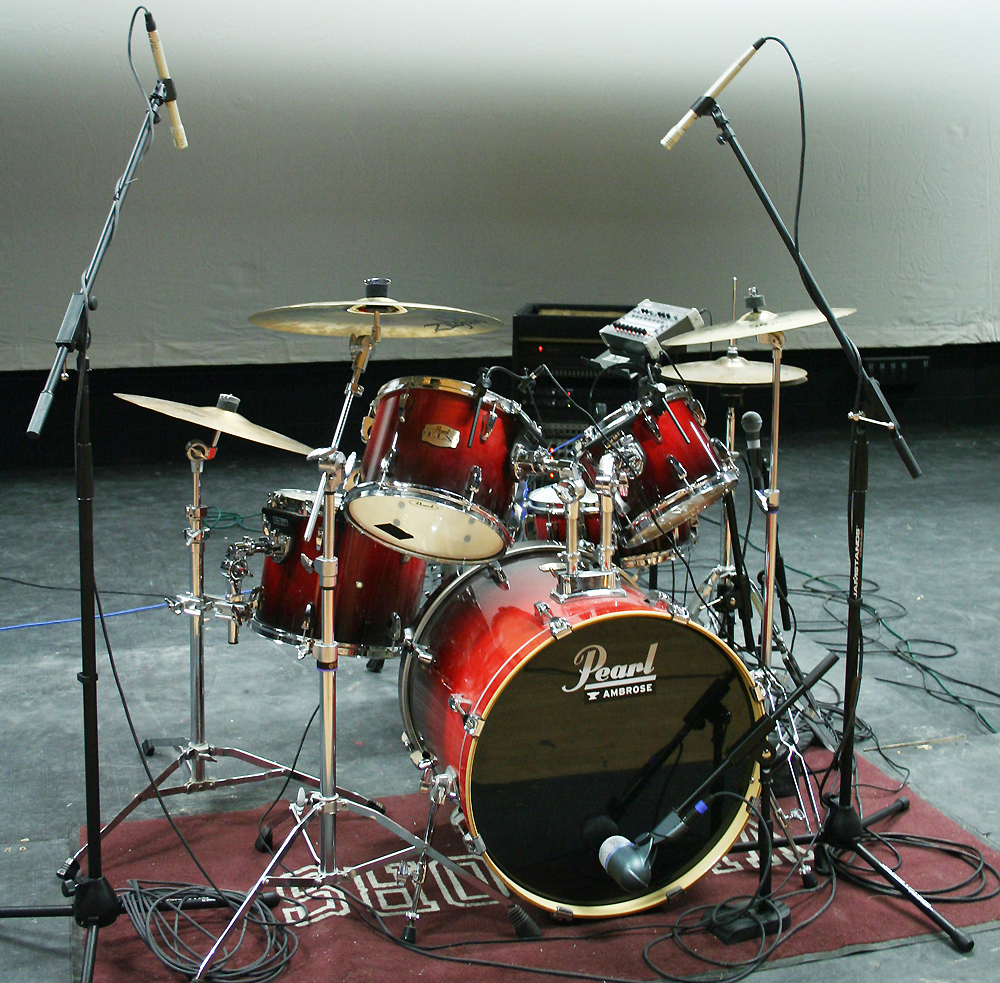
Note that this approach only works with acts that have quiet stage volume because the mics are located rather far from the drums, and they can also pick up other louder instruments. A variation on the technique uses a shotgun or hypercardioid mic in the front position, with the tighter pattern reducing the potential of stage bleed.
Here’s another one deployed for a show with a seven-piece band with horn players and only an eight-channel mixer. (The main console died for some reason and we only had the small mixer as a backup for the opening acts while a truck was dispatched to get another console.)
I arranged the three horns around a single mic, and utilized three direct boxes (DIs) on the two keyboards and bass guitar. The drum kit was captured with a pair of condensers overhead and a mic on the kick. A wireless system with handheld transmitter was plugged into a line input, provided to the band leader/sax player so he could talk to the audience between songs.
This gig (and a corporate show where the main console also failed) are the reasons I always now carry a 16-input “utility” mixer as a backup on every gig.
Change In Plans
Recently I was freelancing for an A/V company that provided a 16-input digital console to handle meetings in a hotel ballroom for the week.
On Friday, the meeting ended at noon and the room was flipped for dinner and a show featuring a performer singing to tracks. In addition to the usual pile of loudspeakers and podium mics for a corporate presentation, the A/V company had also provided some subwoofers, stage monitors and a wireless system (with backup) for the singer.
During the transition of the room, I was on stage unplugging the podium mics when a guy with some keyboards showed up. He informed me that the singer would be accompanied by a live band, and in fact, they were unloading as we spoke.
I realized that there might not be enough mics (and stands) to handle the expanded setup, and quickly took stock of what was available on site. The keyboard player could go mono, and we had some DI boxes, so that was covered. The bass player’s amp had an XLR output so we could go direct to the PA. A dynamic handheld serving as a board mic was repurposed for the guitar player – I draped the cable around his amp handle and hung the mic in front of the loudspeaker.
Now it was time to figure out the five-piece drum kit. Two dynamics that had been used for audience Q+A (question and answer) during the meeting could be repurposed, and I always carry an extra dynamic in my gig bag, so there were three handheld mics for drums, along with a few 18-inch gooseneck podium mics (the type with XLR connectors on the end). We also scrounged up three round-base/straight stands as well as a desk stand.
The dynamic mic from my gig bag was applied for the kick because it would handle the higher SPL and offered response down to 50 Hz. It was positioned inside the drum with the desk stand, which rested on a folded tablecloth borrowed from the hotel to provide some isolation.
With only the straight stands to work with, traditional overhead placement was out of the question. Instead, my solution was to place two podium mics on the stands to act as overheads, with the tall goosenecks providing much-needed extra reach and flexibility in aiming. These flanked the kit, one pointed down at the floor tom and the other pointed down at the rack toms.
One of the audience mics went into the last stand, directed at the hi-hat, while the other was gaff-taped to the hi-hat stand and pointed to capture the snare. While none of these mic selections were “ideal,” it all still worked quite well. (Both my A1 and the lighting tech back me up on this.)
One other neat trick is to position a podium mic underneath a ride cymbal. It’s out of the way of the drummer (and the sticks), with the gooseneck allowing easy positioning for tailoring, and is a great way to get some of the “ping” of the ride cymbal into the mix. Podium mics also come in handy on hi-hat.
The moral of the story is that while it’s ideal to have a mic on every drum and overheads on the kit, sometimes we need to come up with creative solutions to make the gig happen, and at as high of a level as possible.

